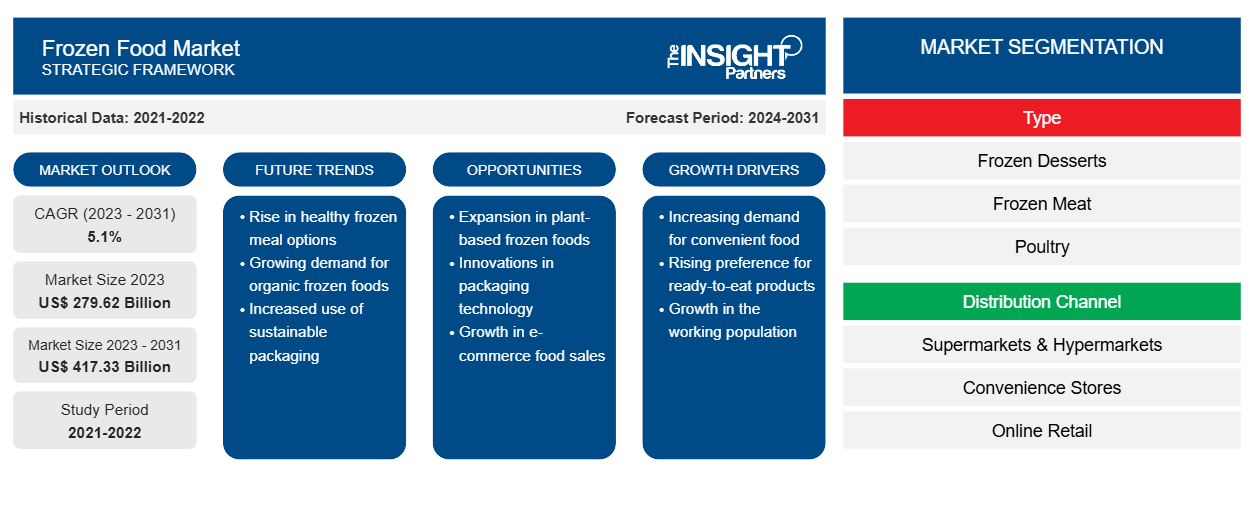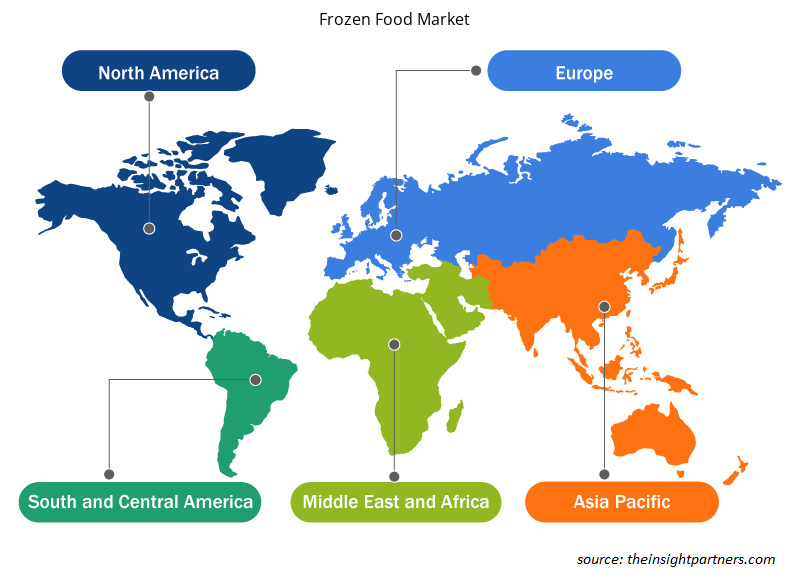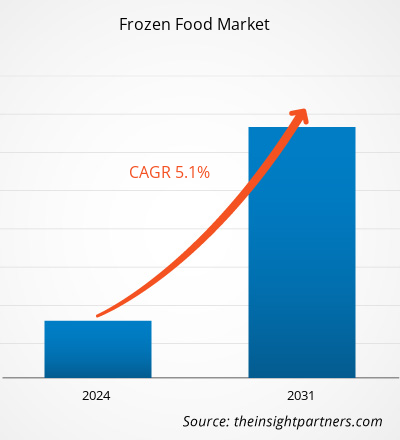냉동식품 시장 규모는 2024년 2억 9,539만 달러에서 2031년 4억 4,422만 달러로 성장할 것으로 예상되며, 예측 기간 동안 연평균 성장률 6.0%를 기록할 것으로 예상됩니다. 비건(Vegan)은 최근 몇 년간 큰 인기를 얻고 있습니다. 소비자들은 식물성 제품이 기존 제품보다 건강에 더 좋다고 생각하기 때문에 식물성 제품에 대한 선호도가 높습니다. 또한, 동물 보호 및 환경 지속가능성에 대한 인식이 높아짐에 따라 이러한 식품의 인기도 높아지고 있습니다. 전 세계적으로 비건 열풍이 확산되면서 냉동식품 시장의 혁신에 큰 영향을 미치고 있습니다.
냉동식품 시장 분석
지난 몇 년 동안 전 세계 사람들의 라이프스타일은 극적으로 변화했습니다. 바쁜 업무 일정으로 인해 시간과 노력을 절약해 주는 제품에 대한 의존도가 높아졌습니다. 고품질 편의식품 소비 급증은 식품 산업의 가장 큰 트렌드 중 하나입니다. 냉동 스낵, 냉동식품, 콜드컷, 즉석식품과 같은 편의식품은 소비자들이 재료 구매, 식사 준비 및 조리, 섭취, 그리고 식후 활동에 드는 시간과 노력을 절약할 수 있도록 해줍니다. 이러한 식품의 발전과 인기는 여러 사회 변화에 기인합니다. 그중에서도 가장 두드러지는 것은 전 세계적으로 소가족화와 밀레니얼 세대의 증가입니다. 바쁜 업무 일정으로 인해 밀레니얼 세대는 지루한 업무에 시간을 허비하기보다는 효율적으로 시간을 활용하는 것을 선호합니다. 따라서 편의식품에 더 많은 돈을 지출할 가능성이 높습니다. 이러한 요인들은 소비자들의 편의식품 수요를 크게 증가시켜 궁극적으로 냉동식품 시장의 성장을 촉진하고 있습니다.
냉동식품 시장 개요
냉동식품에는 아이스크림, 냉동 요구르트, 냉동육, 냉동 해산물, 냉동 간편식, 스낵, 애피타이저, 수프, 과일, 채소 등이 포함됩니다. 이러한 제품은 영하 25도에서 냉동 보관됩니다. 냉동식품은 인공 방부제를 사용하지 않아 다른 가공식품보다 건강에 좋습니다. 또한, 화씨 0도의 가정용 냉동고에 쉽게 보관할 수 있습니다. 바쁜 생활 방식으로 인한 편의식품 수요 증가는 냉동식품 시장의 성장을 견인하고 있습니다. 급속한 도시화, 1인당 소득 증가, 그리고 변화하는 소매 환경은 냉동식품 시장 성장을 견인하는 주요 요인입니다.
귀하의 요구 사항에 맞게 이 보고서를 사용자 정의하세요
이 보고서의 일부 또는 국가 수준 분석, Excel 데이터 팩을 포함하여 모든 보고서에 대한 사용자 정의를 무료로 받을 수 있으며, 신생 기업 및 대학을 위한 훌륭한 혜택과 할인도 이용할 수 있습니다.
냉동식품 시장: 전략적 통찰력

-
이 보고서에서 주요 시장 동향을 알아보세요.이 무료 샘플에는 시장 동향부터 추정치 및 예측까지 다양한 데이터 분석이 포함됩니다.
냉동식품 시장의 동인과 기회
전자상거래의 번창은 시장을 선호한다
사람들은 냉동식품 구매를 위해 점점 더 온라인 소매 플랫폼을 선호하고 있습니다. 미국 냉동식품연구소(American Frozen Food Institute)에 따르면, 2020년 냉동식품 온라인 판매는 75% 증가했습니다. 팬데믹 기간 동안 오프라인 매장의 폐쇄와 정부의 사회적 제한 조치로 인해 식음료 온라인 판매가 크게 증가했습니다. 봉쇄 조치로 인해 이동이 제한되고 재택근무를 해야 함에 따라 온라인 쇼핑으로의 전환이 크게 이루어졌습니다. 또한, 높은 할인율, 다양한 브랜드의 제품을 한 곳에서 구매할 수 있는 폭 넓은 접근성, 그리고 택배 배송 옵션 또한 소비자들이 온라인 쇼핑에 집중하는 주요 요인이었습니다. 다양한 지역에서 전자상거래가 확대됨에 따라 켈로그, 코나그라와 같은 냉동식품 제조업체들은 아마존, 리들, 월마트와 같은 유명 전자상거래 플랫폼을 통해 제품을 판매하며 온라인 입지를 확대하고 있습니다. 이러한 요인은 오프라인 매장에 대한 의존도를 낮춰 냉동식품 시장의 성장에 기여하고 있습니다.
제조업체의 전략적 개발 이니셔티브 - 기회
냉동식품 제조업체들은 고객 기반을 확대하고 새로운 소비자 트렌드를 충족하기 위해 제품 혁신에 상당한 투자를 하고 있습니다. 글루텐 프리, 식물성, 무설탕, 유기농, 클린 라벨 제품은 물론, 케토 다이어트에 적합한 제품까지 출시하여 소비자의 다양한 요구를 충족하고 있습니다. 예를 들어, 2021년 8월, 냉동식품 업계의 유명 브랜드인 Real Good Foods Company는 미국 전역 1,500개 크로거 매장에 단백질이 풍부하고 탄수화물이 적으며 곡물이 없고 글루텐이 없는 7가지 새로운 냉동 제품 카테고리를 출시한다고 발표했습니다. 마찬가지로, 2022년에는 냉동식품을 제공하는 인도의 대표 브랜드 Prasuma가 냉동식품 포트폴리오에 냉동 스낵 제품을 출시했습니다. 새롭게 출시된 제품은 냉동 야채 및 치킨 스프링롤, 냉동 치킨 너겟, 치킨 및 야채 미니 사모사, 치킨 및 양고기 샤미 케밥, 시크 케밥이며, 베이컨도 냉동 스낵 제품 포트폴리오에 추가되었습니다. 이 제품들은 세계적 위기 속에서 전 세계 소비자들의 건강이 최우선 과제가 되면서, 소비자들이 건강 목표를 달성하고 건강한 식사를 즐길 수 있도록 돕기 위해 출시되었습니다. 사람들이 식단의 영양 균형을 유지하면서 간편식에 관심을 갖게 되면서, 제조업체들은 영양이 강화된 냉동 제품을 출시하고 있습니다. 이러한 제품 혁신은 제조업체들이 해외 시장에서 사업 영역을 확장하고 경쟁 우위를 확보하는 데 도움이 됩니다.
냉동식품 시장 보고서 세분화 분석
냉동식품 시장 분석에 기여한 주요 부문은 유형과 유통 채널입니다.
- 냉동식품 시장은 유형에 따라 냉동 디저트, 냉동 육류, 가금류 및 해산물, 냉동 베이커리, 냉동 스낵 및 전채 요리, 냉동 식사 등으로 구분됩니다.
- 유통채널 측면에서 보면 시장은 슈퍼마켓과 하이퍼마켓 , 편의점, 온라인 소매점, 기타로 구분됩니다.
지역별 냉동식품 시장 점유율 분석
냉동식품 시장 보고서의 지리적 범위는 주로 북미, 아시아 태평양, 유럽, 중동 및 아프리카, 남미/남중미의 5개 지역으로 나뉩니다.
유럽은 냉동식품 시장을 장악해 왔습니다. 유럽 냉동식품 시장은 독일, 프랑스, 이탈리아, 영국, 러시아, 그리고 유럽 기타 지역으로 구분됩니다. 시장 성장은 주로 편의식품 수요 증가, 광범위한 소매 인프라, 그리고 다양한 유통 채널을 통해 다양한 브랜드의 다양한 제품 공급에 기인합니다. 또한, 1인당 소득이 높은 소비자들의 증가는 냉동식품(냉동 식사 및 간식 등) 수요를 견인하고 있습니다. 소비자들은 섭취하는 제품에서 영양적 이점을 추구합니다. 따라서 깨끗하고 유기농이며 글루텐 프리 이고 가공 과정을 최소화한 냉동식품에 대한 수요가 크게 증가하여 유럽 지역 시장 성장을 촉진하고 있습니다.
냉동식품 시장 지역별 통찰력
Insight Partners의 분석가들은 예측 기간 동안 냉동식품 시장에 영향을 미치는 지역별 동향과 요인들을 면밀히 분석했습니다. 이 섹션에서는 북미, 유럽, 아시아 태평양, 중동 및 아프리카, 그리고 중남미 지역의 냉동식품 시장 세분화 및 지역별 분포도 살펴봅니다.

- 냉동식품 시장의 지역별 데이터 얻기
냉동식품 시장 보고서 범위
| 보고서 속성 | 세부 |
|---|---|
| 2024년 시장 규모 | 2억 9,539만 달러 |
| 2031년까지 시장 규모 | 4억 4,422만 달러 |
| 글로벌 CAGR(2025~2031년) | 6.0% |
| 역사적 데이터 | 2021-2023 |
| 예측 기간 | 2025-2031 |
| 다루는 세그먼트 |
유형별
|
| 포함된 지역 및 국가 |
북아메리카
|
| 시장 선도 기업 및 주요 회사 프로필 |
|
냉동식품 시장 참여자 밀도: 비즈니스 역학에 미치는 영향 이해
냉동식품 시장은 소비자 선호도 변화, 기술 발전, 그리고 제품의 효능에 대한 인식 제고 등으로 최종 소비자 수요가 증가하면서 빠르게 성장하고 있습니다. 수요가 증가함에 따라 기업들은 제품 라인업을 확장하고, 소비자 니즈를 충족하기 위한 혁신을 추진하며, 새로운 트렌드를 적극 활용하고 있으며, 이는 시장 성장을 더욱 가속화하고 있습니다.
시장 참여자 밀도는 특정 시장이나 산업 내에서 활동하는 기업들의 분포를 나타냅니다. 이는 특정 시장 공간에 얼마나 많은 경쟁자(시장 참여자)가 존재하는지를 규모나 전체 시장 가치 대비로 나타냅니다.
냉동식품 시장에서 활동하는 주요 기업은 다음과 같습니다.
- 코나그라 브랜드
- 제너럴 밀스
- 페퍼리지 팜 주식회사
- 본듀엘 그룹
- 맥케인 푸드 리미티드
- 벨리시오푸드 주식회사
면책 조항 : 위에 나열된 회사는 특정 순서에 따라 순위가 매겨지지 않았습니다.

- 냉동식품 시장의 주요 기업 개요를 알아보세요
냉동식품 시장 소식 및 최근 동향
냉동식품 시장은 1차 및 2차 조사 이후 주요 기업 간행물, 협회 자료, 데이터베이스 등 정성적 및 정량적 데이터를 수집하여 평가합니다. 다음은 언어 장애 시장 동향과 전략 목록입니다.
- 2022년 White Castle은 Bellisio Foods와의 파트너십을 통해 소매 식품 제공을 확대하여 전국의 소매점에 상징적인 치킨 링을 제공합니다(Whistle Castle/회사 웹사이트)
냉동식품 시장 보고서 범위 및 제공물
"냉동식품 시장 규모 및 예측(2021~2031)" 보고서는 아래 영역을 포괄하여 시장에 대한 자세한 분석을 제공합니다.
- 범위에 포함된 모든 주요 시장 부문에 대한 글로벌, 지역 및 국가 수준의 시장 규모 및 예측
- 동인, 제약 및 주요 기회와 같은 시장 역학
- 주요 미래 동향
- 자세한 PEST/포터의 5가지 힘 및 SWOT 분석
- 주요 시장 동향, 주요 참여자, 규정 및 최근 시장 개발 사항을 다루는 글로벌 및 지역 시장 분석
- 시장 집중도, 히트맵 분석, 주요 업체 및 최근 개발 사항을 포함하는 산업 환경 및 경쟁 분석
- 자세한 회사 프로필
- 과거 분석(2년), 기준 연도, CAGR을 포함한 예측(7년)
- PEST 및 SWOT 분석
- 시장 규모 가치/거래량 - 글로벌, 지역, 국가
- 산업 및 경쟁 환경
- Excel 데이터세트
최근 보고서
관련 보고서
사용 후기
구매 이유
- 정보에 기반한 의사 결정
- 시장 역학 이해
- 경쟁 분석
- 고객 인사이트
- 시장 예측
- 위험 완화
- 전략 기획
- 투자 타당성 분석
- 신흥 시장 파악
- 마케팅 전략 강화
- 운영 효율성 향상
- 규제 동향에 발맞춰 대응






















 무료 샘플 받기 - 냉동식품 시장
무료 샘플 받기 - 냉동식품 시장